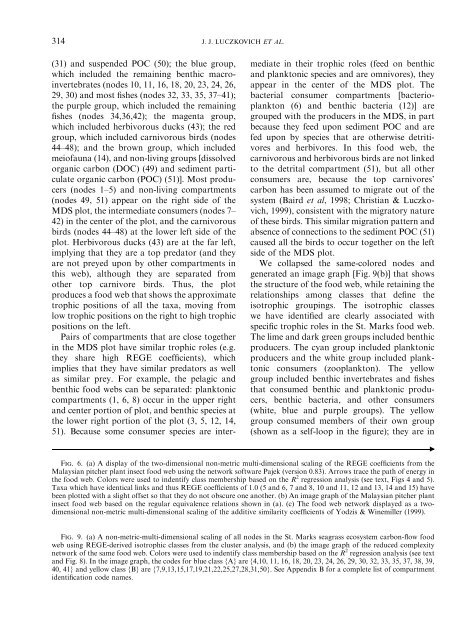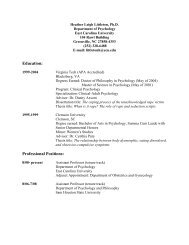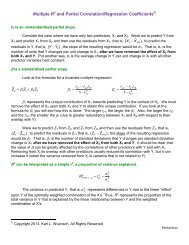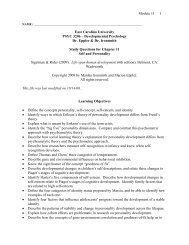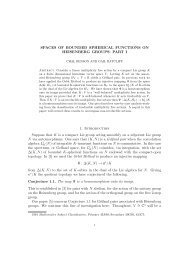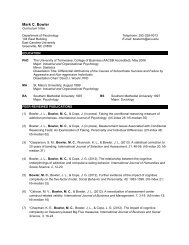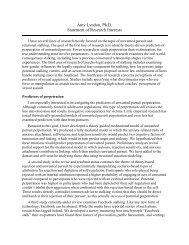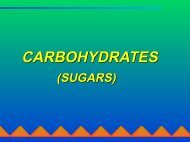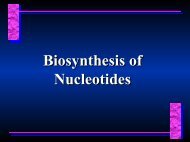Defining and Measuring Trophic Role Similarity in Food Webs Using ...
Defining and Measuring Trophic Role Similarity in Food Webs Using ...
Defining and Measuring Trophic Role Similarity in Food Webs Using ...
Create successful ePaper yourself
Turn your PDF publications into a flip-book with our unique Google optimized e-Paper software.
314J. J. LUCZKOVICH ET AL.(31) <strong>and</strong> suspended POC (50); the blue group,which <strong>in</strong>cluded the rema<strong>in</strong><strong>in</strong>g benthic macro<strong>in</strong>vertebrates(nodes 10, 11, 16, 18, 20, 23, 24, 26,29, 30) <strong>and</strong> most fishes (nodes 32, 33, 35, 37–41);the purple group, which <strong>in</strong>cluded the rema<strong>in</strong><strong>in</strong>gfishes (nodes 34,36,42); the magenta group,which <strong>in</strong>cluded herbivorous ducks (43); the redgroup, which <strong>in</strong>cluded carnivorous birds (nodes44–48); <strong>and</strong> the brown group, which <strong>in</strong>cludedmeiofauna (14), <strong>and</strong> non-liv<strong>in</strong>g groups [dissolvedorganic carbon (DOC) (49) <strong>and</strong> sediment particulateorganic carbon (POC) (51)]. Most producers(nodes 1–5) <strong>and</strong> non-liv<strong>in</strong>g compartments(nodes 49, 51) appear on the right side of theMDS plot, the <strong>in</strong>termediate consumers (nodes 7–42) <strong>in</strong> the center of the plot, <strong>and</strong> the carnivorousbirds (nodes 44–48) at the lower left side of theplot. Herbivorous ducks (43) are at the far left,imply<strong>in</strong>g that they are a top predator (<strong>and</strong> theyare not preyed upon by other compartments <strong>in</strong>this web), although they are separated fromother top carnivore birds. Thus, the plotproduces a food web that shows the approximatetrophic positions of all the taxa, mov<strong>in</strong>g fromlow trophic positions on the right to high trophicpositions on the left.Pairs of compartments that are close together<strong>in</strong> the MDS plot have similar trophic roles (e.g.they share high REGE coefficients), whichimplies that they have similar predators as wellas similar prey. For example, the pelagic <strong>and</strong>benthic food webs can be separated: planktoniccompartments (1, 6, 8) occur <strong>in</strong> the upper right<strong>and</strong> center portion of plot, <strong>and</strong> benthic species atthe lower right portion of the plot (3, 5, 12, 14,51). Because some consumer species are <strong>in</strong>termediate<strong>in</strong> their trophic roles (feed on benthic<strong>and</strong> planktonic species <strong>and</strong> are omnivores), theyappear <strong>in</strong> the center of the MDS plot. Thebacterial consumer compartments [bacterioplankton(6) <strong>and</strong> benthic bacteria (12)] aregrouped with the producers <strong>in</strong> the MDS, <strong>in</strong> partbecause they feed upon sediment POC <strong>and</strong> arefed upon by species that are otherwise detritivores<strong>and</strong> herbivores. In this food web, thecarnivorous <strong>and</strong> herbivorous birds are not l<strong>in</strong>kedto the detrital compartment (51), but all otherconsumers are, because the top carnivores’carbon has been assumed to migrate out of thesystem(Baird et al, 1998; Christian & Luczkovich,1999), consistent with the migratory natureof these birds. This similar migration pattern <strong>and</strong>absence of connections to the sediment POC (51)caused all the birds to occur together on the leftside of the MDS plot.We collapsed the same-colored nodes <strong>and</strong>generated an image graph [Fig. 9(b)] that showsthe structure of the food web, while reta<strong>in</strong><strong>in</strong>g therelationships among classes that def<strong>in</strong>e theisotrophic group<strong>in</strong>gs. The isotrophic classeswe have identified are clearly associated withspecific trophic roles <strong>in</strong> the St. Marks food web.The lime <strong>and</strong> dark green groups <strong>in</strong>cluded benthicproducers. The cyan group <strong>in</strong>cluded planktonicproducers <strong>and</strong> the white group <strong>in</strong>cluded planktonicconsumers (zooplankton). The yellowgroup <strong>in</strong>cluded benthic <strong>in</strong>vertebrates <strong>and</strong> fishesthat consumed benthic <strong>and</strong> planktonic producers,benthic bacteria, <strong>and</strong> other consumers(white, blue <strong>and</strong> purple groups). The yellowgroup consumed members of their own group(shown as a self-loop <strong>in</strong> the figure); they are <strong>in</strong>Fig. 6. (a) A display of the two-dimensional non-metric multi-dimensional scal<strong>in</strong>g of the REGE coefficients from theMalaysian pitcher plant <strong>in</strong>sect food web us<strong>in</strong>g the network software Pajek (version 0.83). Arrows trace the path of energy <strong>in</strong>the food web. Colors were used to <strong>in</strong>dentify class membership based on the R 2 regression analysis (see text, Figs 4 <strong>and</strong> 5).Taxa which have identical l<strong>in</strong>ks <strong>and</strong> thus REGE coefficients of 1.0 (5 <strong>and</strong> 6, 7 <strong>and</strong> 8, 10 <strong>and</strong> 11, 12 <strong>and</strong> 13, 14 <strong>and</strong> 15) havebeen plotted with a slight offset so that they do not obscure one another. (b) An image graph of the Malaysian pitcher plant<strong>in</strong>sect food web based on the regular equivalence relations shown <strong>in</strong> (a). (c) The food web network displayed as a twodimensionalnon-metric multi-dimensional scal<strong>in</strong>g of the additive similarity coefficients of Yodzis & W<strong>in</strong>emiller (1999).cFig. 9. (a) A non-metric-multi-dimensional scal<strong>in</strong>g of all nodes <strong>in</strong> the St. Marks seagrass ecosystem carbon-flow foodweb us<strong>in</strong>g REGE-derived isotrophic classes from the cluster analysis, <strong>and</strong> (b) the image graph of the reduced complexitynetwork of the same food web. Colors were used to <strong>in</strong>dentify class membership based on the R 2 regression analysis (see text<strong>and</strong> Fig. 8). In the image graph, the codes for blue class {A} are {4,10, 11, 16, 18, 20, 23, 24, 26, 29, 30, 32, 33, 35, 37, 38, 39,40, 41} <strong>and</strong> yellow class {B} are {7,9,13,15,17,19,21,22,25,27,28,31,50}. See Appendix B for a complete list of compartmentidentification code names.


